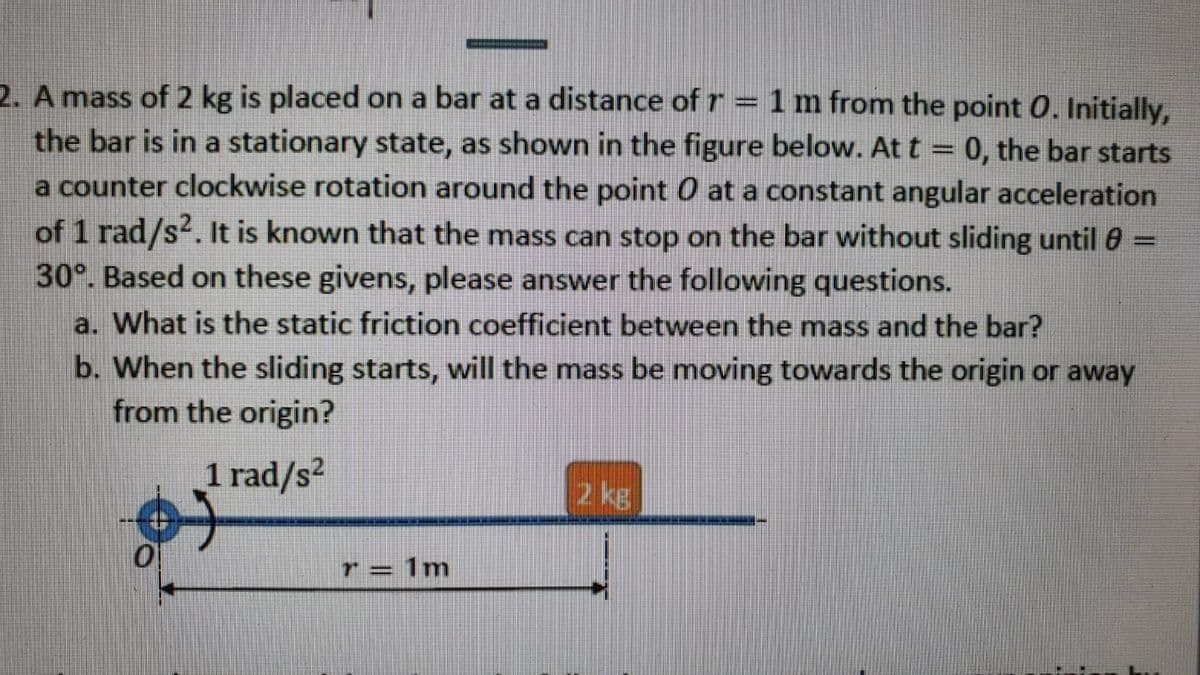A mass of 2 kg is placed on a bar at a distance of r the bar is in a stationary state, as shown in the figure below. At t = 0, the bar starts a counter clockwise rotation around the point 0 at a constant angular acceleration of 1 rad/s?. It is known that the mass can stop on the bar without sliding until 0 = 30°. Based on these givens, please answer the following questions. 1 m from the point 0. Initially, %3D %3D a. What is the static friction coefficient between the mass and the bar? b. When the sliding starts, will the mass be moving towards the origin or away from the origin? 1 rad/s2 2 kg r = 1m
A mass of 2 kg is placed on a bar at a distance of r the bar is in a stationary state, as shown in the figure below. At t = 0, the bar starts a counter clockwise rotation around the point 0 at a constant angular acceleration of 1 rad/s?. It is known that the mass can stop on the bar without sliding until 0 = 30°. Based on these givens, please answer the following questions. 1 m from the point 0. Initially, %3D %3D a. What is the static friction coefficient between the mass and the bar? b. When the sliding starts, will the mass be moving towards the origin or away from the origin? 1 rad/s2 2 kg r = 1m
Elements Of Electromagnetics
7th Edition
ISBN:9780190698614
Author:Sadiku, Matthew N. O.
Publisher:Sadiku, Matthew N. O.
ChapterMA: Math Assessment
Section: Chapter Questions
Problem 1.1MA
Related questions
Question

Transcribed Image Text:2. A mass of 2 kg is placed on a bar at a distance of r = 1 m from the point 0. Initially,
the bar is in a stationary state, as shown in the figure below. At t = 0, the bar starts
a counter clockwise rotation around the point O at a constant angular acceleration
of 1 rad/s?. It is known that the mass can stop on the bar without sliding until 0 =
30°. Based on these givens, please answer the following questions.
a. What is the static friction coefficient between the mass and the bar?
b. When the sliding starts, will the mass be moving towards the origin or away
from the origin?
1 rad/s?
2 kg
r = 1m
Expert Solution
This question has been solved!
Explore an expertly crafted, step-by-step solution for a thorough understanding of key concepts.
Step by step
Solved in 3 steps with 1 images

Knowledge Booster
Learn more about
Need a deep-dive on the concept behind this application? Look no further. Learn more about this topic, mechanical-engineering and related others by exploring similar questions and additional content below.Recommended textbooks for you

Elements Of Electromagnetics
Mechanical Engineering
ISBN:
9780190698614
Author:
Sadiku, Matthew N. O.
Publisher:
Oxford University Press

Mechanics of Materials (10th Edition)
Mechanical Engineering
ISBN:
9780134319650
Author:
Russell C. Hibbeler
Publisher:
PEARSON

Thermodynamics: An Engineering Approach
Mechanical Engineering
ISBN:
9781259822674
Author:
Yunus A. Cengel Dr., Michael A. Boles
Publisher:
McGraw-Hill Education

Elements Of Electromagnetics
Mechanical Engineering
ISBN:
9780190698614
Author:
Sadiku, Matthew N. O.
Publisher:
Oxford University Press

Mechanics of Materials (10th Edition)
Mechanical Engineering
ISBN:
9780134319650
Author:
Russell C. Hibbeler
Publisher:
PEARSON

Thermodynamics: An Engineering Approach
Mechanical Engineering
ISBN:
9781259822674
Author:
Yunus A. Cengel Dr., Michael A. Boles
Publisher:
McGraw-Hill Education

Control Systems Engineering
Mechanical Engineering
ISBN:
9781118170519
Author:
Norman S. Nise
Publisher:
WILEY

Mechanics of Materials (MindTap Course List)
Mechanical Engineering
ISBN:
9781337093347
Author:
Barry J. Goodno, James M. Gere
Publisher:
Cengage Learning

Engineering Mechanics: Statics
Mechanical Engineering
ISBN:
9781118807330
Author:
James L. Meriam, L. G. Kraige, J. N. Bolton
Publisher:
WILEY